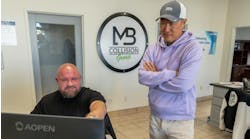Testing Last spring, I visited a company that makes sunroofs, convertible tops and a line of what they call ?temperature management' products. The company's name is Webasto, and though based in Germany, they've just opened two locations in the United States, so we'll be hearing more about them soon. On this trip, I toured manufacturing plants and engineering facilities, and by the time it was all over, something that I've vaguely known for a long time suddenly came into sharp focus.
Webasto's engineering labs have small environmental chambers for testing components under extreme temperature and humidity conditions. Their anechoic chambers can hold an entire vehicle for testing a sunroof's operating noise. They also have the largest environmental chamber in Europe, big enough for three class-8 truck tractors, where they can generate extreme heat or cold and 80 mph winds. The endurance test labs can subject sunroofs and tops to rain, vibration, dirt and 10,000 operating cycles, and there's also a test-to-destruction lab. One lab tests electronic components and software, and another tests motors for RF interference. I could mention several more, but the point is this: The amount of testing that goes into developing a sliding glass sunroof is simply amazing. The company's annual R&D budget is over 100 million euros, about US$1.2 million, and from what I saw, the lion's share probably goes into testing sunroofs and convertible tops.
That money is overhead ?It's all spent to learn what works and what doesn't.
If that's what it costs to develop a sunroof, imagine what a company spends to develop a new engine. Thousands of dyno hours ? at X dollars per hour ? are needed to satisfy the manufacturer's and also the government's requirements. And when testing shows a change is needed ? after all, that's what testing is for ? the dyno costs just keep climbing.
Imagine the cost of developing a new unibody, matching it with a chassis and driveline, then adding an interior and restraint systems, just so you can crash test it to see what happens to the occupants. The car also has to be sent to the ends of the earth for testing at high altitude and extreme summer and winter conditions. Although I don't have any numbers to support this, I bet there are as many test technicians in the world as there are repair technicians.
I've toured test labs at car manufacturers and Tier 1 suppliers and at companies that make petroleum products, filters, brake pads, shock absorbers and electronics. I've worked as a test lab technician on gaskets, diesel injection systems and catalytic converters. I've seen the kind of money spent on development testing for automobiles and all the bits and pieces that go into them. That money is overhead. Rarely does it generate a return by streamlining a production process or reducing material costs. It's all spent to learn what works and what doesn't.
Standing at the door of a multimillion dollar test chamber that costs thousands of dollars per hour to run, wondering how many sunroofs they need to sell to pay for those tests, it suddenly dawned on me just how sophisticated today's cars really are. And even more amazing is that they're affordable. The auto industry builds one of the most complex pieces of technology this side of a jet airliner and spends billions of dollars testing it, yet the cost of buying and operating a car is still within reach of average people. This is the state of the automobile today, and its affect on society has been profound. Amazing.




